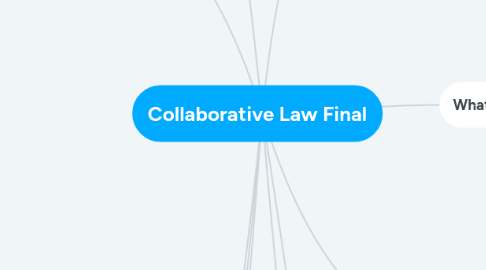
1. Not a good candidate for collaborative law:
1.1. When one side does not want to be honest with the other side
1.2. When family violence is present
1.3. When mental illness is present
2. Process
2.1. Initial Consultation
2.1.1. Is your client's case a good fit for collaborative law?
2.1.2. explain the concept/process of collaborative law to your client
2.1.3. Explaining the time commitment of the process
2.2. Planning session
2.2.1. Now that we are going to do collaborative, how should we proceed?
2.2.2. the first meeting of both parties and their attorneys is reserved for the creation and review of the collaborative agreement.
2.2.3. The nature and scope of the negotiations
2.2.3.1. ex: Hiring a professional business evaluator -in order to understand the value of a small family owned business
2.2.4. Divide responsibilities between the parties for collecting information
2.3. Negotiation preparation
2.3.1. these pre-meeting sessions with only your client can include, but are not limited to, issue framing, information gathering, consultation with experts, and so on
2.3.2. Most importantly, negotiation prep requires the attorney to prepare their client for the type of negotiations they will soon face in the collaborative law process
2.4. Things to consider in negotiation preparation
2.4.1. Your interest
2.4.2. Their interest
2.4.3. My resources/ability to handle the case
2.4.4. Their resources/abilities to handle the case
2.4.5. Value creating options -----ZOPA (zone of possible agreement)
2.4.6. Is there a standard value? (guidelines)
2.4.6.1. My BATNA (best alternative to a negotiated Agreement)
2.4.6.2. Their BANTA
2.4.7. Method to negotiate
2.4.7.1. How do I and my client interact?
2.4.7.2. How does the opposing party interact with their client?
2.5. Negation sessions
2.5.1. these meeting can be as numerous as necessary to fully explore the parties conflict and settle their negotiation. Information can be gathered during these meetings and experts may sit in
2.5.1.1. The frequency and intensity of meeting depends not only on the parties conflict, but also on their ability to cooperate on their attorneys ability to peacefully guide the negotiation
2.6. Presentation to the court
2.6.1. Once consensus is reached and the agreement is finalized and signed, the parties may present it to the court for approval
2.6.1.1. EX: QDRO
2.6.1.2. EX: splitting a 401K
3. Mediation difference
3.1. No central moderator
3.2. Recognition of structure
4. Collective thinking
4.1. The Wisdom of crowds: averaging the answers of a group is more likely to be accurate than looking at all individual answers
4.2. Good collective decisions require two components: deliberation and diversity of opinions.
5. Guiding people to making decisions:
5.1. There are other options—to splitting assets: More than one way to skin a cat
5.2. Lawyers help determine the size of the pie
5.3. Come up with multiple options, once you know those you can move towards preference
5.3.1. Don’t rush to the conclusion aka don't just state the obvious answer, because it may not be the obvious answer to the group only you.
6. Tensions to consider
6.1. Principal v. Agent
6.1.1. Parenting time should be fair, NO BIOC
6.1.2. Difference between what THINK your client wants, and what your client wants
6.2. Empathy v. Assertiveness
6.3. Creating value v. Distributing value
6.3.1. Only one way to cut a pie, but we can decide how big the pie is
7. Why collaborative law?
7.1. Courts are not healthy or efficient ways to deal with issues
7.1.1. collaborative law allows you to avoid these issues
7.1.2. Ex: Move away case
7.2. A process through which if people are willing to invest, it has a therapeutic effect on their family group & re-tools the family with skills they did not have before.
8. What is collaborative?
8.1. Collaborative law is a voluntary, contractually based alternative dispute resolution process for parties who seek to negotiate a resolution of their matter rather than having a ruling imposed upon them by a court or arbitrator.
8.2. Both parties are represented by attorneys- Attorneys should have some type of collaborative training
9. Reflexive listening
9.1. Don’t just try and fix it- have to acknowledge that you don’t have that experience, and cohabitate the feelings
9.2. Need to be willing to enter into the clients space
9.3. Remember you have an agenda to find common ground
9.4. Not a value distribution problem, cant argue who is a better parent...more likely to be seen as not the better parent
10. Benefit of being a "good" attorney
10.1. Forgiving
10.2. They are nice and start with cooperation
10.2.1. Offensive behavior rarely gets results
10.3. Not too complex
10.4. Civility was more effective than aggressiveness
10.4.1. Lawyers who belittle do not serve clients interests

